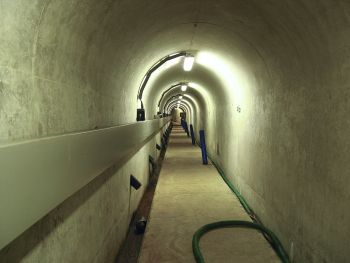Confined Space Entry

|
| Inspection gallery beneath Roadford Dam.
(Image Source: Wikimedia) |
Confined space entry is crucial to dam maintenance and inspection. Dams often have confined spaces, such as tunnels, galleries, or chambers, which require careful planning and adherence to safety protocols when accessing them.
The primary objective of confined space entry in dams is to perform maintenance, inspections, and repairs. Often, critical infrastructure components, such as gates, valves and instrumentation systems that need regular inspection and maintenance are in confined spaces. Thus, confined space entry is the only way engineers and technicians can assess the condition of these components, identify potential issues, and conduct necessary maintenance.
Confined spaces in dams present various hazards to the safety of personnel entering these areas. Common hazards include limited ventilation, the presence of hazardous gases or chemicals, restricted entry or exit points, and the potential for entrapment. To mitigate these risks, strict safety measures must be implemented, including proper ventilation, air monitoring, the use of personal protective equipment (PPE), and a permit-only entry system. Regular hazard assessments and emergency response protocols are essential to minimize risks and ensure the safety of personnel.
Prior to entering a confined space, clear communication channels must be established between the personnel inside the confined space and the designated attendants outside. This continuous chain of monitoring enables efficient coordination and a quick response in case of emergencies. Adequate training is also essential for personnel entering the confined space, ensuring they are aware of the potential hazards, understand the safety protocol, and can respond effectively to any potential emergencies.
Confined space entry requires thorough pre-entry preparation, and a comprehensive assessment of the area must be conducted. Testing includes atmospheric testing, identification of potential hazards, and evaluation of rescue and emergency response capabilities. Proper permit systems, lockout/tagout procedures, and isolation measures must also be implemented to ensure the safety of individuals entering the confined space. Equipment checks, PPE requirements, and communication protocols should be established and followed diligently in all situations to minimize risks.
Confined space entry is an ongoing process for dams that permits continuous monitoring and evaluation. Regular inspections and assessments are necessary to identify any changes in the confined spaces, ensure compliance with safety protocols, and update procedures if required. Lessons learned from previous entries and incidents should be incorporated into future safety protocols. By consistently monitoring and evaluating confined space entry procedures, current practices can be improved, and risks can be further minimized.
